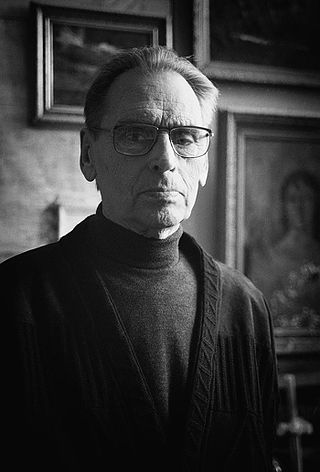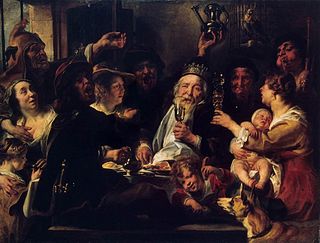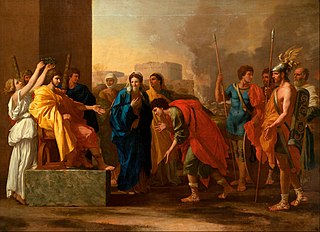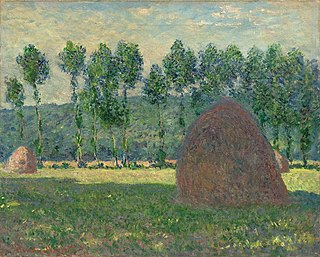
Victor Kuzmich Teterin was a Russian painter, watercolorist, and art teacher, who lived and worked in Leningrad. He is regarded as one of the important representatives of the Leningrad school of painting.
Vladislav Leopoldovich Anisovich was a Russian and Soviet painter and art educator, who lived and worked in Leningrad, a member of the Leningrad Union of Soviet Artists, professor of the Repin Institute of Arts, regarded as one of representatives of the Leningrad School of Painting. Mostly known for his portrait paintings.

Lev Konstantinovich Bogomolets was a Soviet Russian painter, a member of the Saint Petersburg Union of Artists, who lived and worked in Saint Petersburg, regarded as one of representatives of the Leningrad school of painting, most famous for his landscape paintings.

Nikolai Alexandrovich Kushelev-Bezborodko was a Russian art collector.

The King Drinks or The Bean King is a c.1638 painting by the Flemish Baroque artist Jacob Jordaens, now in the Hermitage Museum in St Petersburg.

Frost in Louveciennes is an 1873 painting by Alfred Sisley, which has been in the Pushkin Museum since 1948. It shows the church of St Martin in the French town of Louveciennes. A chalk sketch for it is now in the Budapest Museum of Fine Arts . The work's early provenance is unknown until on 3 May 1902 Paul Durand-Ruel bought it for 9300 francs at the sale of Jules Strauss's collection at the Hotel Drout auction house. In 1903 Durand-Ruel sold it on to Ivan Morozov - it was one of his first acquisitions. The Pushkin Museum holds a 22 June 1903 letter from Durand-Ruel to Morozov agreeing to sell the work for 11,500 francs, despite this being a big sacrifice for his gallery, and a 27 June receipt for receiving the money.

The Guard Room is a 1642 oil-on-panel painting by David Teniers the Younger, now in the Hermitage Museum in St Petersburg. It is signed and dated "David Teniers F. 1642" at the bottom left. Several unsigned but probably autograph variants also survive, such as at the Catherine Palace near St Petersburg and the Walters Art Museum in Baltimore, USA. An early copy by an unknown artist after the Hermitage work is now in the National Museum of Sweden.

The Oude Voetboog Guild in the Grote Markt is a 1643 oil-on-canvas painting by David Teniers the Younger, in the collection of the Hermitage Museum, in Saint Petersburg. It is signed and dated bottom left "DAVID. TENIERS. FEC. A 1643".

Rest on the Flight into Egypt is a c. 1604 oil on canvas painting by Annibale Carracci.

Self-Portrait in Profile is a 1590s oil on canvas painting by Annibale Carracci, acquired by Leopoldo de' Medici and now part of the collection of artists' self-portraits in the Uffizi, which also includes another self-portrait. As of 1686 it hung alongside another portrait previously thought to be another Carracci self-portrait

The Healing of Tobit or Tobias Healing His Father is a 1621-1622 oil on panel painting by Domenico Fetti, now in Room 232 of the Hermitage Museum. It shows a scene from the Book of Tobit, with the archangel Raphael helping Tobias to heal his blind father Tobit. Several autograph and non-autograph copies of the work also survive, including an autograph in the Barbarigo family collection in Venice which entered the Hermitage in 1850 but was later sold, probably to P V Delarov, after whose death it was auctioned at Georges Petit in Paris in 1914.

Portrait of a Woman is a 1641 oil on panel painting by the Dutch artist Hendrick Cornelisz. van Vliet, now in Room 249 of the Hermitage Museum, in Saint Petersburg.

Zerubbabel Before Darius is an oil on oak panel painting by Nikolaus Knüpfer, now in the Hermitage Museum, in Saint Petersburg. It was dated to after 1644 by Jo Saxton, a date also accepted by the work's owner. The work is signed at the foot of the throne on the left hand side. The frame is significantly damaged and the bottom right of the panel is chipped away.

The Lovers, Two Lovers or Love Scene is an oil painting by Giulio Romano, originally painted on panel and later transferred to canvas by A Mitrokin in 1834. Since it was poorly stored and kept off public display due to its subject matter until 1920, it has significant damage, including three large breaks in the canvas sealed with coarse plasters on the reverse and other damage to the paint and varnish layer both before and after the transfer It now hangs in the Hermitage Museum.

Holy Family, also called The Rest on the Flight into Egypt, is an oil on canvas painting by the French Rococo artist Antoine Watteau, now in the Hermitage Museum, Saint Petersburg. Variously dated between 1714 and 1721, Holy Family is possibly the rarest surviving religious subject in Watteau's art, related to either the Gospel of Matthew, or the Gospel of Pseudo-Matthew; it depicts the Virgin, the Christ Child, and Saint Joseph amid a landscape, surrounded by putti.

Assumption is a c. 1623 oil-on-canvas painting of the Assumption of Mary by the Italian artist Guercino, now in the Hermitage Museum in Saint Petersburg.

The Continence of Scipio is a 1640 oil on canvas painting by Nicolas Poussin, commissioned by Abbé Gian Maria Roscioli, secretary to Pope Urban VIII. It changed owners several times, reaching the Walpole collection in the first half of the 18th century, from which it was bought for the Hermitage Museum by Catherine the Great in 1779. It was reassigned to the Pushkin Museum in 1930, where it remains. The painting is based on the historical continence of Scipio.

Landscape with Hercules and Cacus is an oil on canvas painting by French painter Nicolas Poussin, created c. 1660. It is held in the Pushkin Museum, in Moscow. It depicts a scene from lines 190-275 of Book VIII of Virgil's Aeneid.

Haystack Near Giverny is an oil on canvas painting by Claude Monet, from 1884. It is held in the Pushkin Museum, in Moscow. It is a precursor to his 1890s Haystacks series.

The Bunch of Flowers or Flowers of France is an oil on canvas painting by Paul Gauguin, from 1891. It is held in the Pushkin Museum in Moscow. It was one of the first in his series of Tahitian works.




















